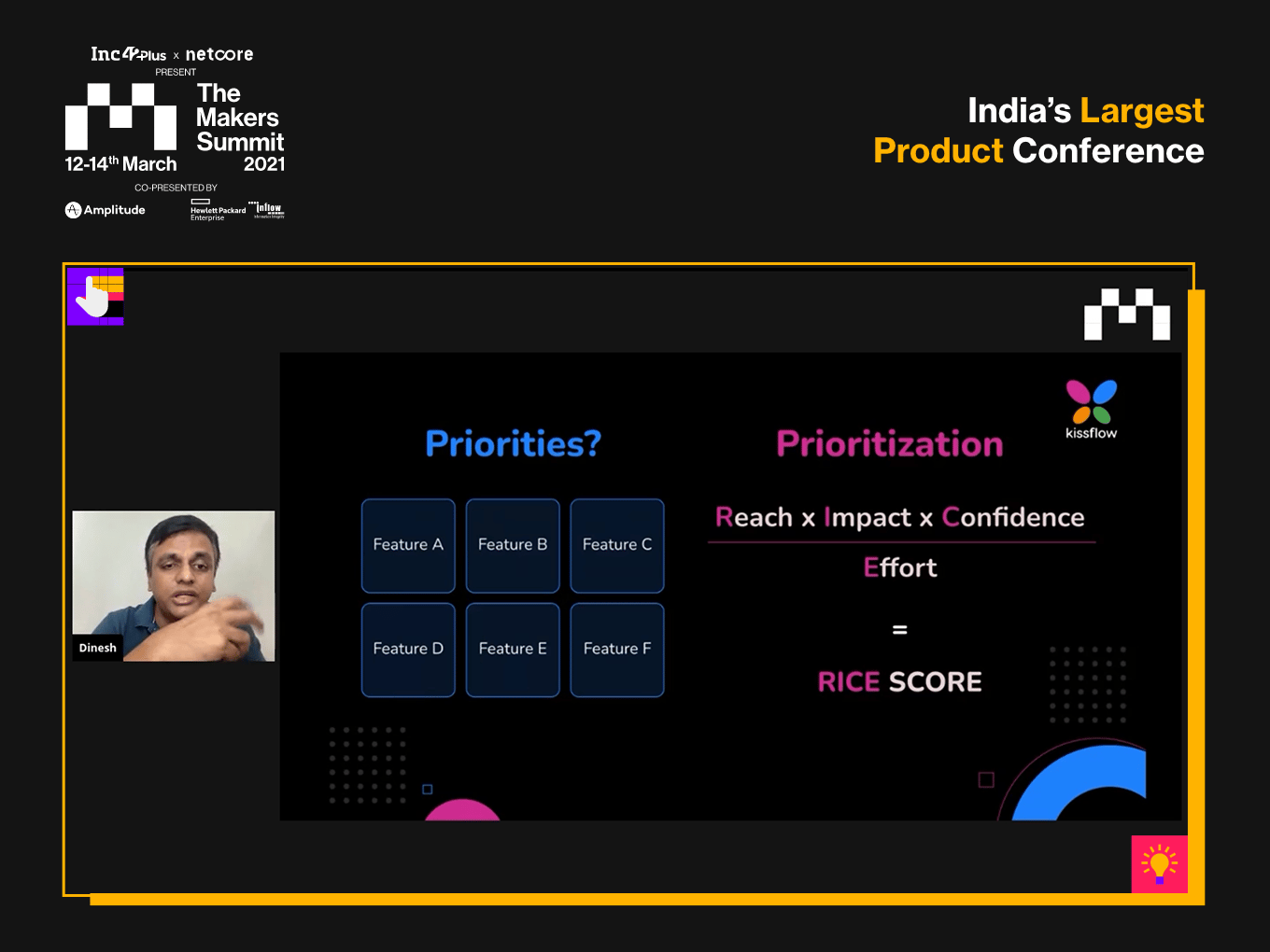Recollecting Kissflow’s journey that began eight years ago with mere 13 team members, Dinesh Varadharajan shared its evolution to almost 270 members today
He believes that product success is linked to team culture and not just about the framework for prioritisation, even though that is also a critical element
Kissflow evolved from a top-down ‘Command’ approach to their internal WINES and RICE frameworks for product development and feature prioritisation inspired by other tech giants
Creating opportunities and bringing ideas to reality is in the hands of the team. That was the gist of the Dinesh Varadharajan masterclass at The Makers Summit 2021. The Kissflow product management VP delved into his team management philosophy and how it aligns with product growth and success in the masterclass ‘Managing Your Team Like A Product’.
Recollecting Kissflow’s journey that began eight years ago with just 13 team members, Varadharajan shared its evolution to almost 270 members today, with the simple mantra of ‘grow big, but stay small’.
Here are the key takeaways from his masterclass and the product team management principles that have made Kissflow one of the most successful SaaS startups in India.
Product Evolution Is Linked To Team Evolution
Varadharajan began by recalling Kissflow’s initial days when they began adding more people to different teams and saw productivity fall sharply despite the expectations to the contrary. Then he looked at how other companies managed teams within teams — particularly, Amazon’s two-pizza teams or Spotify’s Squad model, which is its take on the scrum system. These are small teams with specific goals put in place to avoid inefficiency. When there are more people in a single team, it is difficult to work together and get a productive output, said the Kissflow product head.
Initially, Kissflow operated according to the ‘Command’ system which was the traditional top-down approach with information flowing from the CEO to down the rung, a strict hierarchical structure. This was then transitioned to the ‘Command of Teams’ which was similar to Spotify’s Squad model.
However, due to the existence of squads as well as different functional departments, dependencies continued to burden the efficiency. And that’s when the magic happened. Kissflow demolished the functional departments and built autonomous squads for every product which involved members from each department.
These squads could now talk to each other without routing dependencies through the higher ranks. This was inspired by the idea of toppling the ‘Iceberg of Ignorance’ where the senior management, which is unaware of the root problem, has to be involved for all resolutions.
“It is about creating a culture that nurtures the team of teams and not a transition or a team structure change.”
He added that leaders practising this new model ought to be passive. Influenced by former US army general Stanley McChrystal (who spearheaded the operations in Afghanistan post 9/11), Varadharajan said that the top management has to practice the ‘Eyes-On, Hands-Off’ technique and just be an enabler rather than a doer.
Why Team Structure Matters In Product Development
To create lucrative products, autonomy has to be awarded to team members. Varadharajan gave us a glimpse into Kissflow’s structure where all product lines are headed by ‘Product Owners’ and each product has a separate team that governs itself. As the startup follows the ‘Team of Teams’ structure, members from different teams can collaborate with each other with greater autonomy.
But if teams are made cross-functional and don’t need managers to connect with other teams, then what is the role played by the functional heads? What does the PM or the head of engineering exactly do?
Varadharajan said that at Kissflow all functional heads are referred to as coaches. They pour their expertise into product lines when the team leads think they can do some value addition. It is more out of respect rather than authority.
Click To Access The Makers Summit 2021 Sessions
Frameworks For Product Teams
Every team works based on a framework. For Kissflow, this was the WINES framework as well as the RICE framework for product development and feature prioritisation. Varadharajan explained the pragmatic WINES framework and how from just handling the technical aspects of a product, the product department team moves to strategising and joins the marketing activities as well. For product novices, the veteran recommended resources such as the Pragmatic Institute to understand the frameworks clearly.
Varadharajan said that a company might miss the woods for the trees if it caters only to the customer’s goals. It will lead to a diversion from the company’s actual vision. And that’s what brought WINES to the fore. All feature requests are put into one of these buckets — Winners, Invisibles, Needs, Experience and Sellers.
Winners refer to those features that drag the product to the company’s vision. They are controlled by the leadership team.
And then there are some features that are of lesser importance and are put into the Invisibles bucket. This category is handled by the engineering team.
The third basket ‘needs’ — is taken care of by the customer success team. It finds out the reason for customer churn, uses the wishlist feature where customers can upvote what features they want in the product, and develop those features that are common to both the lists.
Experience matters a lot and UX is the differentiator for Kissflow, said Varadharajan. Product designers track every feature that has been added and monitor how it is being used via internally developed dashboards.
The last bucket is ‘sellers’. This is owned by the sales team and is crucial to understanding why potential revenue sources aren’t showing results.
Besides the WINES framework, Kissflow also uses the RICE method to prioritise different features. With a RICE score, features can be prioritised accordingly.
Thus, every role in the product team is carefully crafted using these frameworks, which clearly define how and what the product managers and the team is supposed to do. Thus, employees marry business expectations with product knowledge to give birth to a successful product.
































 Ad-lite browsing experience
Ad-lite browsing experience